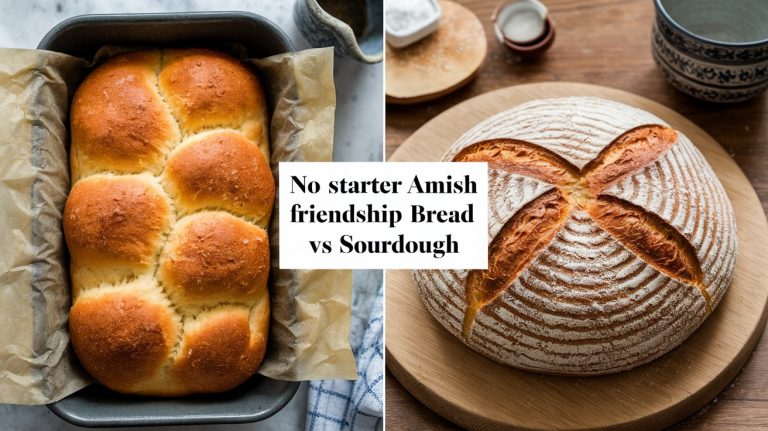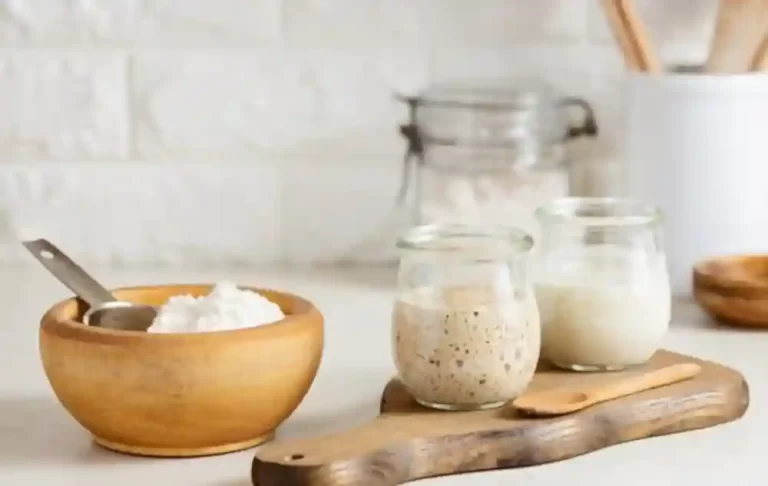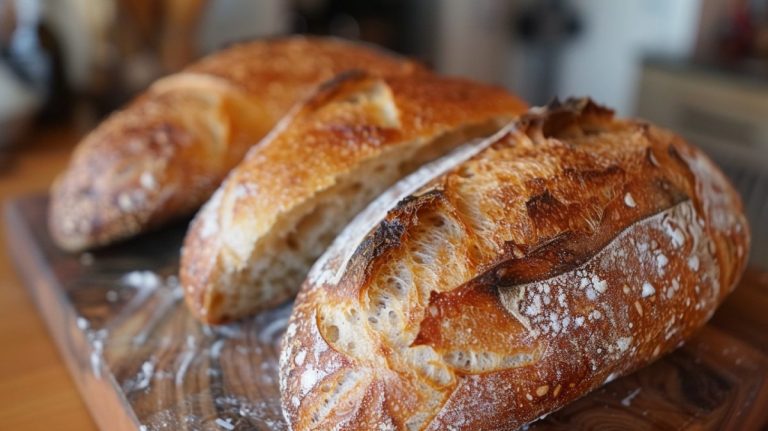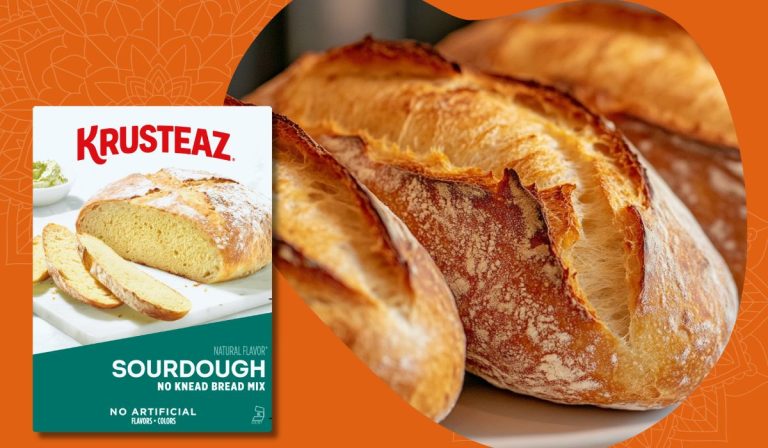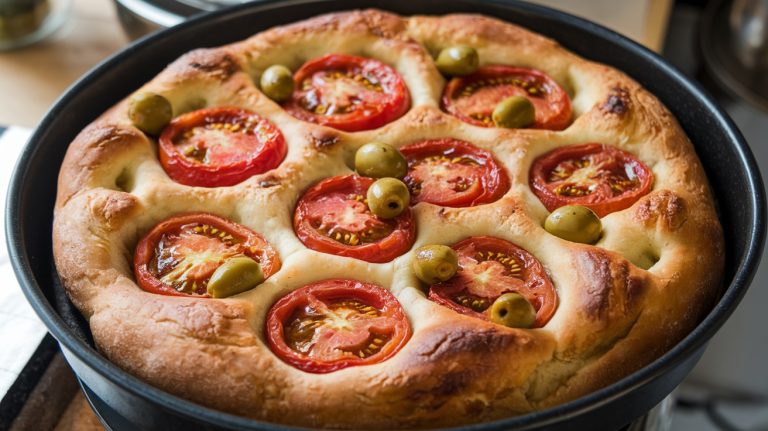Sourdough Discard Beignets: Sweet Bites, Wellness Inside
Got sourdough discard? Turn it into delicious beignets! Start by mixing 375g bread flour with warm milk at 110°F, ⅓ cup sugar, and 3 tbsp melted butter.
Add your discard and a pinch of baking powder for lift. Knead until soft, roll into a ¼-inch rectangle, and cut 3×3-inch squares. Fry at 330-350°F until golden, then dust with powdered sugar. Stick around to uncover secrets for the perfect fluffy, tangy treat.
Key Takeaways
- Use 375g bread flour and mix in sourdough discard with warm milk at 110°F (43°C) to activate yeast.
- Add baking powder to the dough for extra lift when using sourdough discard.
- Roll dough to ¼-inch thickness, cut into 3×3-inch squares, and let rise for 1½ to 2 hours.
- Fry at 330-350°F (165-175°C) in neutral oil, flipping after 1-2 minutes until golden and puffed.
- Dust with powdered sugar within 2-3 minutes post-frying for a perfect sweet coating.
Crafting the Perfect Dough
While crafting the perfect dough for sourdough discard beignets might seem intimidating, you’ll find it’s a rewarding process with the right approach.
Start with 375g of bread flour for strong gluten structure, and warm your milk to exactly 110°F (43°C) to activate the yeast without harm. Add ⅓ cup of sugar for balanced sweetness and 3 tbsp of melted, cooled butter for tenderness. If using discard, mix in baking powder for lift.
Knead with a stand mixer’s dough hook for 5–10 minutes until the dough’s soft, slightly sticky, and passes the windowpane test. Keep ingredients at room temperature to avoid shocking the starter. Remember, using an active sourdough starter can enhance the flavor and fermentation flexibility.
Let it bulk ferment for 4–6 hours, doubling in size, to develop that signature sourdough tang. Maintain a consistent dough temperature around 75°F (24°C) to ensure optimal yeast performance during fermentation.
Shaping and Preparing Beignets
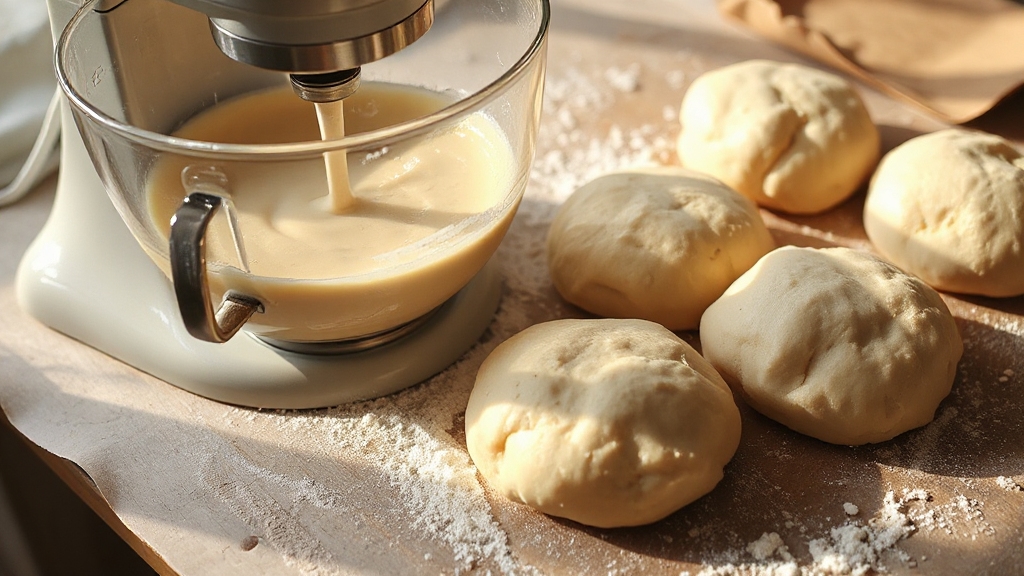
After your sourdough discard dough has completed its bulk fermentation, it’s time to transform it into delightful beignets with proper shaping and preparation.
Grab a rolling pin and roll the dough on a lightly floured surface into a ¼-inch thick rectangle. Don’t stress about perfection—beignets don’t need exact measurements. Use a pastry wheel or sharp knife to cut the dough into 3×3-inch squares for larger treats, trimming edges if needed.
Roll your sourdough discard dough into a ¼-inch thick rectangle, then cut into 3×3-inch squares. No need for perfection—beignets are forgiving!
Place the cut beignets on a parchment-lined baking sheet, ensuring they’re not crowded. Cover them with a tea towel to retain humidity and let them rise in a warm spot for 1½ to 2 hours. This second proofing helps achieve their signature light and puffy texture. Using a KitchenAid mixer with a dough hook attachment can streamline the initial kneading process for consistent results.
Watch for over-proofing signs like collapse, and keep them near your workspace for easy access.
Mastering the Frying Technique
Now that your beignets are shaped and have risen to perfection, it’s time to tackle the art of frying them to golden, fluffy bliss. Heat your oil to 330-350°F (165-175°C) in a deep pan or Dutch oven, using a reliable thermometer to maintain consistency. Choose a neutral oil like canola for its high smoke point, and keep the depth at 2-3 inches.
Fry in small batches, flipping each beignet after 1-2 minutes per side until puffed and golden. Use a spider strainer for safe removal. For best results, ensure the oil stays close to 345-350°F range to achieve that perfect golden brown color. Drawing from baking techniques, aim for an internal temperature of 190°F to ensure the beignets are fully cooked.
Here’s a quick guide to frying success:
| Tip | Why It Matters |
|---|---|
| Monitor temperature | Prevents burning or undercooking |
| Use fresh oil | Avoids smoking and off-flavors |
| Fry in batches | Guarantees even cooking |
| Flip frequently | Achieves uniform golden color |
| Handle oil safely | Reduces risk of burns |
Adding the Final Sweet Touch
As soon as your beignets emerge golden and crisp from the fryer, it’s time to crown them with the iconic sweet touch that defines this treat.
Grab a fine-mesh sieve and generously sift powdered sugar over them within 2-3 minutes post-frying to guarantee it sticks. For full coverage, try the paper bag method—toss warm beignets with 120-240g of sugar for that melt-in-mouth texture. To ensure precision in measuring your sugar, consider using a reliable digital baking scale for consistent results.
Dust your freshly fried beignets with powdered sugar using a fine-mesh sieve within minutes for that perfect, sticky sweetness.
Want a twist? Mix in cinnamon or citrus zest for a nontraditional flair. Place them on a cooling rack first to avoid sogginess, aiming for 160°F before dusting to prevent melting. Remember to fry at the correct temperature of 350°F for perfection.
Sift carefully to avoid clumps, creating that snow-like coating.
Serving and Enjoying Freshly Made Beignets

Envision this: three golden beignets, straight from the fryer, dusted with a snowy layer of powdered sugar, beckoning you to dig in.
You’ve gotta act fast—serve ‘em within 5–10 minutes for that perfect crisp exterior and pillowy inside. The aroma’s irresistible, and the Instagram-worthy sugar mountain’s a visual treat, but watch out for the heat to avoid a burnt tongue.
Here’s how to enjoy them right:
- Pair ‘em up: Sip café au lait or chicory coffee for a true New Orleans vibe.
- Set the scene: Keep a sugar shaker handy for extra dusting.
- Mind the mess: Grab napkins—sugar “snowfall” is inevitable.
- Share the love: Split a plate to spark conversation and connection.
- Savor the warmth: Enjoy them hot for maximum flavor to capture the essence of this classic treat.
Frequently Asked Questions
Can I Use Active Starter Instead of Discard?
Hey, you’re wondering if you can swap active starter for discard in a recipe, right? You absolutely can, but you’ve gotta make adjustments.
Active starter brings live yeast, so expect longer fermentation for natural rise and a tangier flavor. Cut back on extra leavening agents like baking powder, and tweak hydration if needed.
Keep an eye on proofing time—it’ll likely stretch out.
What Is the Nutritional Value of Beignets?
Hey, think of beignets as a sweet, fluffy trap—much like a siren’s song luring sailors to rocky shores, they tempt you with sugary bliss.
You’re biting into 188–262 calories per piece, with 14–41.7g of sugar and 9.1–45.8g of fat. They’re low in nutrients, offering just trace iron and calcium.
Watch out, though—sodium hits 57% of your daily limit per cup. Tread carefully with portions.
How Do Beignets Relate to Mardi Gras?
Hey, immerse yourself in the vibrant connection between beignets and Mardi Gras!
You’ll find these fluffy, powdered sugar-dusted treats embody the spirit of Fat Tuesday, a day of indulgence before Lenten restraint. Savor them as a pre-fasting ritual, symbolizing excess and celebration.
In New Orleans, you can’t miss beignet shops buzzing with tourists, especially in the French Quarter. They’re a cultural staple, tying you to festive traditions.
Can I Bake Beignets Instead of Frying?
Did you know baked beignets can cut calories by nearly 50% compared to fried ones? You can absolutely bake beignets instead of frying them!
Preheat your oven to 350℉-400℉, roll out your dough, and cut it into squares. Brush on an egg wash for that golden hue, let ’em proof, then bake.
After, coat ’em with melted butter and powdered sugar for authentic, lighter treats.
What Other Desserts Use Sourdough Discard?
Hey, you’re curious about desserts that use sourdough discard, right?
Immerse yourself in making tangy Vanilla Cake with a tender crumb or whip up Sourdough Brownies for a fudgy, crackly treat.
Try Chocolate Chip Cookies for a unique depth of flavor, or bake a fluffy Sourdough Discard Strawberry Cake for a sweet afternoon snack.
Don’t forget Cobblers like cherry for extra flair.
The Irresistible Sugary Bliss Meets Gut Health
You’ve just crafted heavenly sourdough discard beignets-golden, crisp, and utterly irresistible! As you savor each sugary, pillowy bite, consider this: could the fermentation in sourdough actually boost your gut health, making these treats a secret superfood?
Science suggests it might, with some probiotics potentially surviving the fry. So indulge with delight-you’re not just enjoying a delicious treat, you could be nurturing your body as well. Share these fluffy gems fresh, and let the sweet magic linger.


